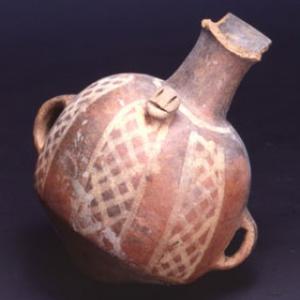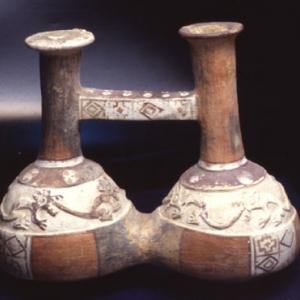The Inca civilisation (1250-1450 A.D.)
When Pizarro landed in Peru, the Inca empire extended beyond the Peruvian region and included the southern area of Ecuador and the northern areas of Chile and Bolivia. The Inca culture appropriated the styles and the productions of the annexed populations, for example in the north the Inca style blended with the Chimú style, giving origin to the so-called Chimú-Inca style.
Inca potters used about twelve different models to produce vases for practical use. Potters decorated them with geometric patterns (circles, dots, chessboards, crosses) and a sort of stylized fern, all painted in black, orange, yellow and white on a dark red or orange background. The shapes of the vessels recall those of previous or coeval civilizations, except for the arybalo, a kind of amphora used to preserve liquids and with a pointed bottom that was buried into the ground. The Incas improved the techniques of the goldsmith’s art thanks to the exceptional ability of the Chimú goldsmiths who migrated to Cuzco.
Arybalo with painted geometric motifs, XV-XVI sec. A.D. (Inca)

Arybalo with painted geometric motifs, XV-XVI sec. A.D. (Inca)

Arybalo with painted geometric motifs, XV-XVI sec. A.D. (Inca)

Arybalo with painted geometric motifs, XV-XVI sec. A.D. (Inca)

Ariballoide vase, XV-XVI sec. A.D (Inca)

Ariballoide vase, XV-XVI sec. A.D (Inca)

Ariballoide vase, XV-XVI sec. A.D (Inca)

Ariballoide vase, XV-XVI sec. A.D (Inca)

Necklace with pendant

Necklace with pendant

Necklace with pendant

Necklace with pendant

Small llama statue

Small llama statue

Small llama statue

Small llama statue

Globular vase shaped like a feline’s head, XV-XVI sec. A.D (Chimù-Inca)

Globular vase shaped like a feline’s head, XV-XVI sec. A.D (Chimù-Inca)

Globular vase shaped like a feline’s head, XV-XVI sec. A.D (Chimù-Inca)

Globular vase shaped like a feline’s head, XV-XVI sec. A.D (Chimù-Inca)

Whistling vessel, XIII sec. A.D. (doubtful), (Inca ?)

Whistling vessel, XIII sec. A.D. (doubtful), (Inca ?)

Whistling vessel, XIII sec. A.D. (doubtful), (Inca ?)

Whistling vessel, XIII sec. A.D. (doubtful), (Inca ?)

Bicameral whistling vessel with bridge handle

Bicameral whistling vessel with bridge handle

Bicameral whistling vessel with bridge handle

Bicameral whistling vessel with bridge handle

Arybalo with snake in relief, XV-XVI sec. A.D. (Chimù-Inca)

Arybalo with snake in relief, XV-XVI sec. A.D. (Chimù-Inca)

Arybalo with snake in relief, XV-XVI sec. A.D. (Chimù-Inca)

Arybalo with snake in relief, XV-XVI sec. A.D. (Chimù-Inca)

Ariballoid vase, XV-XVI sec. A.D (Chimù-Inca)

Ariballoid vase, XV-XVI sec. A.D (Chimù-Inca)

Ariballoid vase, XV-XVI sec. A.D (Chimù-Inca)

Ariballoid vase, XV-XVI sec. A.D (Chimù-Inca)

Arybalo, XV-XVI sec. A.D. (Chimù-Inca)

Arybalo, XV-XVI sec. A.D. (Chimù-Inca)

Arybalo, XV-XVI sec. A.D. (Chimù-Inca)

Arybalo, XV-XVI sec. A.D. (Chimù-Inca)

Two-chamber whistling vessel, XV-XVI sec. A.D (Chimù-Inca)

Two-chamber whistling vessel, XV-XVI sec. A.D (Chimù-Inca)

Two-chamber whistling vessel, XV-XVI sec. A.D (Chimù-Inca)

Two-chamber whistling vessel, XV-XVI sec. A.D (Chimù-Inca)

Ariballoid vase, XV-XVI sec. A.D. (Inca)

Ariballoid vase, XV-XVI sec. A.D. (Inca)

Ariballoid vase, XV-XVI sec. A.D. (Inca)

Ariballoid vase, XV-XVI sec. A.D. (Inca)

Two-chamber whistle vase with bridge loop, XV-XVI sec. A.D (Chimù-Inca)

Two-chamber whistle vase with bridge loop, XV-XVI sec. A.D (Chimù-Inca)

Two-chamber whistle vase with bridge loop, XV-XVI sec. A.D (Chimù-Inca)

Two-chamber whistle vase with bridge loop, XV-XVI sec. A.D (Chimù-Inca)

Arybalo with painted geometric motifs, XV-XVI sec. A.D. (Inca)

Arybalo with painted geometric motifs, XV-XVI sec. A.D. (Inca)

Arybalo with painted geometric motifs, XV-XVI sec. A.D. (Inca)

Arybalo with painted geometric motifs, XV-XVI sec. A.D. (Inca)

Vase with two-chamber bridge loop, XV-XVI sec. A.D (Chimù-Inca)

Vase with two-chamber bridge loop, XV-XVI sec. A.D (Chimù-Inca)

Vase with two-chamber bridge loop, XV-XVI sec. A.D (Chimù-Inca)

Vase with two-chamber bridge loop, XV-XVI sec. A.D (Chimù-Inca)

Amphora cephalomorph, XV-XVI sec. A.D (Chimù-Inca)

Amphora cephalomorph, XV-XVI sec. A.D (Chimù-Inca)

Amphora cephalomorph, XV-XVI sec. A.D (Chimù-Inca)

Amphora cephalomorph, XV-XVI sec. A.D (Chimù-Inca)

Pumpkin-shaped vase XV-XVI sec. A.D. (Chimù-Inca)

Pumpkin-shaped vase XV-XVI sec. A.D. (Chimù-Inca)

Pumpkin-shaped vase XV-XVI sec. A.D. (Chimù-Inca)

Pumpkin-shaped vase XV-XVI sec. A.D. (Chimù-Inca)

Arybalo, XV-XVI sec. A.D. (Chimù-Inca)

Arybalo, XV-XVI sec. A.D. (Chimù-Inca)

Arybalo, XV-XVI sec. A.D. (Chimù-Inca)

Arybalo, XV-XVI sec. A.D. (Chimù-Inca)

Figurine in the shape of armadillo XV-XVI sec. A.D (Inca)

Figurine in the shape of armadillo XV-XVI sec. A.D (Inca)

Figurine in the shape of armadillo XV-XVI sec. A.D (Inca)

Figurine in the shape of armadillo XV-XVI sec. A.D (Inca)

Composition - Inca

Composition - Inca

Composition - Inca

Composition - Inca





